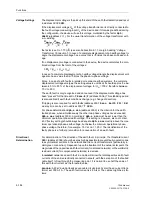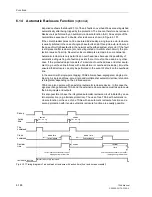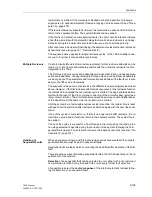
Functions
6-194
7SA6 Manual
C53000-G1176-C156-2
The sequence described above applies to a single reclosure cycle. In the 7SA6 multi-
ple reclosure (up to 8 cycles) is also possible (see below).
Sequence of a
Single-pole
Reclose Cycle
Single-pole reclose cycles are only possible with the appropriate device version and if
this was selected during the configuration of the protection functions (address
110
,
see also section 5.1). Of course, the circuit-breaker must also be suitable for single-
pole tripping.
If the automatic reclosure function is ready, the short-circuit protection trips single pole
for all single-phase faults inside the stage valid for reclosure. It can also be selected
(address
1156A
Trip2phFlt
, see also section 6.1.3), by setting, that single-pole
tripping takes place for two-phase faults without earth. Single-pole tripping is of course
only possible with short-circuit protection functions that can determine the faulty
phase.
If only single-pole reclosure is selected then the short-circuit protection issues a final
three-pole trip with the stage that is valid without reclosure. Every three-pole trip is fi-
nal. The automatic reclosure is blocked dynamically (see also above under subtitle
“Reclose Block”, page 191).
The automatic reclosure function is started following a single-pole trip. The (adjusta-
ble) dead time for the single-pole reclose cycles starts with reset of the trip command
or opening of the circuit-breaker pole (auxiliary contact criterion). The circuit-breaker
receives a close command after the dead time. At the same time the (adjustable) re-
claim time is started. If the reclosure is blocked during the dead time following a single-
pole trip, optional immediate three-pole tripping can take place (Forced Three-pole
Trip, page 207).
If the fault has been cleared (successful reclosure), the reclaim time runs out and all
functions return to their quiescent state. The system fault has ended.
If the fault is not cleared (unsuccessful reclosure), the short-circuit protection issues a
final trip with the protection stage that is valid without reclosure. Any fault during the
reclaim time also leads to a final trip.
After unsuccessful reclosure (final tripping) the automatic reclosure function is blocked
dynamically (see also page 191, “Reclose Block”)
The sequence described above applies to single reclose cycles. In the 7SA6 multiple
reclosure (up to 8 cycles) is also possible (see below).
Sequence of a
Single and
Three-pole
Reclose Cycle
This operating mode is only possible with the appropriate device version and if this
was selected during configuration of the protection functions (address
110
, see also
section 5.1). Of course, the circuit-breaker must also be suitable for single-pole trip-
ping.
If the automatic reclosure function is ready, the short-circuit protection trips single-
pole for single-phase faults and three-pole for multi-phase faults. Under
Power Sys-
tem Data 2 (P.System Data 2)
(address
1156A
, see also Section 6.1.3) it can
also be selected that single-pole tripping takes place for two-phase faults without
earth. Single-pole tripping is of course only possible with short-circuit protection func-
tions that can determine the faulty phase. The valid protection stage valid for reclosure
ready state applies for all fault types.
The automatic reclosure function is started at the instant of a trip. Depending on the
type of fault the (adjustable) dead time for the single-pole reclose cycle or the (sepa-
rately adjustable) dead time for the three-pole reclose cycle starts following the reset
of the trip command or opening of the circuit-breaker (pole). After expiry of the dead
time the circuit-breaker receives a close command. At the same time the (adjustable)
Summary of Contents for siprotec 7SA6
Page 2: ...Siemens Aktiengesellschaft Book No C53000 G1176 C156 2 ...
Page 18: ...xviii 7SA6 Manual C53000 G1176 C156 2 ...
Page 32: ...Introduction 1 14 7SA6 Manual C53000 G1176 C156 2 ...
Page 82: ...Hardware and Connections 2 50 7SA6 Manual C53000 G1176 C156 2 ...
Page 119: ...SIPROTEC 4 Devices 4 25 7SA6 Manual C53000 G1176 C156 2 Figure 4 20 CFC Logic example ...
Page 190: ...Configuration 5 62 7SA6 Manual C53000 G1176 C156 2 ...
Page 652: ...Installation and Commissioning 8 78 7SA6 Manual C53000 G1176 C156 2 ...
Page 724: ...Technical Data 10 56 7SA6 Manual C53000 G1176 C156 ...
Page 800: ...Appendix A 76 7SA6 Manual C53000 G1176 C156 2 ...
Page 866: ...Appendix B 66 7SA6 Manual C53000 G1176 C156 2 ...
















































